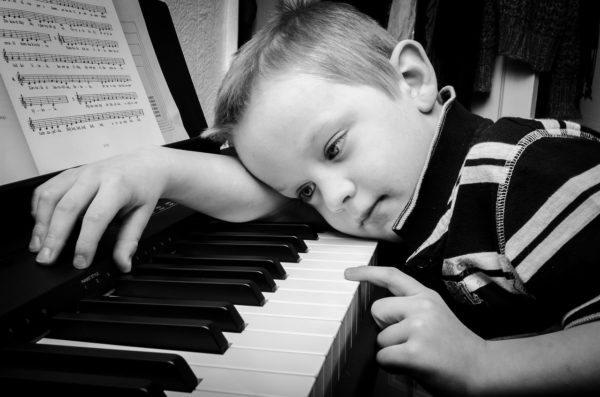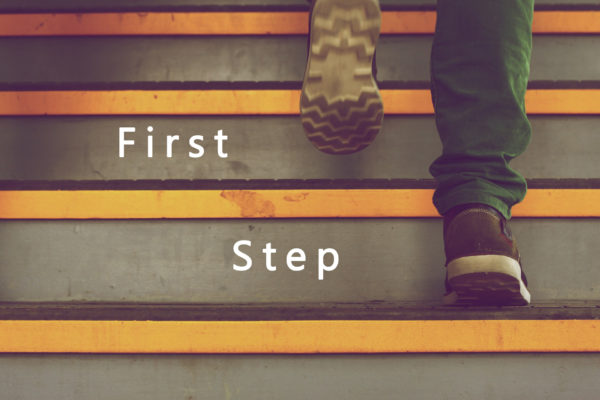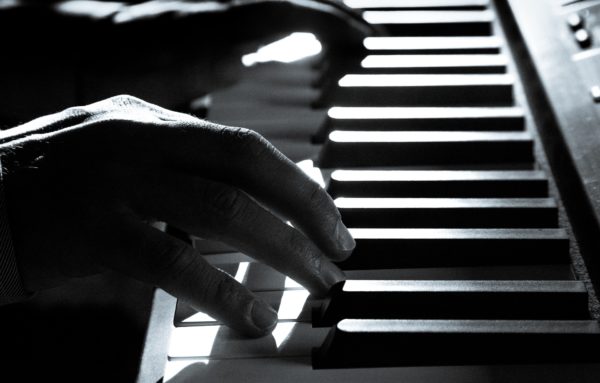
自分が思ったとおりの雰囲気を作り出すメロディーを、ピアノで即興できたらカッコイイですよね。
特にそういった人達を見ると、不思議と聞き入ってしまいますし、なぜか自分のピアノのモチベーションが上がったりするものです。
最近はYouTubeなどのインターネットで、コメントに出てくるお題を即興で演奏して人々を楽しませるようなミュージシャンが増えてきました。
そういう映像を見て「私もあんなふうに即興できたらな~」と思ってしまうのは自然なことです。
最初の即興は残念な結果に

実際ピアノを触れたことがあるほとんどの人が、「適当に演奏する」、いわゆる即興をしたことがあるでしょう。
難しく「作曲」・「即興」と考えなくても、楽譜を見ないで鍵盤をあるがままに弾くことです。
特に幼少期にピアノやピアニカに触れたときにみんなやることですよね?
しかし大抵はその演奏は、耳障りな不協和音になって、すぐに飽きてしまいます。
あなたもその一人ではないでしょうか。
ではどのようにして「即興を練習」すればいいのでしょうか。
もちろん通常の楽譜を使った演奏を繰り返せば自然と身についてくる技術ではありますが、これは「即興を目的」とした練習方法ではありません。
前置きが長くなりましたが、私が考える即興の練習を紹介します。
即興練習の第一歩とは

結論から書くと即興のための第一歩の練習は「アレンジ」です。
これは、
「曲のメロディーを変化させていく」
ものではありません。
「曲の伴奏部を変化させていくもの」
です。
「メロディーを変化させていく」のも貴重なピアノ練習ですが、これはどちらかというと第2歩以降の練習に近いように感じます。
まずは音の合わせ方を知るべきだと私は思います。
なによりこっちのほうが楽しいですからね。
初心者の方に最初から「曲を自由に作ってください。」と言われても、天才の作曲家でもない限りそんな事はできません。
九九をしらない小学生に「掛け算、割り算の問題を自由に作ってください」と言っているようなものです。
まずは、音を合わせる訓練と、合わせた音がつくる雰囲気を体感する必要があるのです。
そのためにも「アレンジ」というのはとても初歩的で効果的なやり方であると言えるやり方だと思います。
練習のポイント

実際に例を挙げていきましょう。
最初は誰もが知っている「きらきら星」のような非常に簡単でシンプルなメロディーがいいです。
きらきら星のメロディーは「ド・ド・ソ・ソ・ラ・ラ・ソ」ですよね。
これに、適当な伴奏を合わせてみましょう。
その際、以下のことを意識してください。
①最初はできるだけ「長い音(全音符)」かつ「単音」から始める
※ただしコードがわかる方はコードの方がいいのです。
②オクターブを絞らない
①については言わずもがなですが、長い音を使ったほうが難易度が低くなるからです。
特に全音符となるとすぐに曲に合う伴奏も見つかりますし、違った雰囲気も作りやすくなります。
②は抜けてしまいがちな要素です。
どうしても楽譜を使った練習ばかりだと、左手は右手の1オクターブ低い方にずれた音を演奏するという先入観が生まれてしまいます。
しかしオクターブを変えるだけでも曲の雰囲気というものは変わるものです。
いくつかの楽譜を演奏したことがある方なら、左手がメロディーのパートになった楽譜を弾いたことがあることでしょう。
きらきら星でも同じようにメロディーよりも高いところに伴奏が入っても問題ありません。
ぜひ様々なオクターブで伴奏をしてみてください。
さいごに
どんな練習でも楽しみながらやりたいですよね。
このアレンジを通した練習は、なにより自由に音を遊びながら、その合わせ方を学べるところが特徴です。
楽譜を使って「とにかく色んな曲を演奏したい」とか「技術を高めたい」というかたも、音を理解することは必ずピアノの演奏にプラスになるはずです。
息抜きと思って、ぜひ自由な演奏を楽しみましょう。
コメントを残す